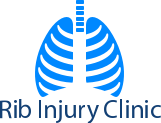Trigger Point, Peripheral nerve and Joint Injections
The role of focused treatment on the source of pain has been used to treat musculoskeletal pain for decades. There are many different approaches combining radiology procedures such as ultrasound guided injections around peripheral nerves or into joints, various needle techniques directly into areas of tenderness (trigger points), physiotherapy methods to target painful areas and treatments using manipulation, ultrasound, heat and cold. Many of these treatments have been applied to the chest wall with various success and can be used with a combination of treatments such as pain management or physiotherapy.
Trigger Point injections
Trigger points, which are usually associated with myofascial pain syndrome, are hyperirritable areas of discrete soft tissue and skeletal muscle that are tender when compressed and can give rise to radiating pain. They can cause muscle spasm, stiffness, shortening, and fatigue, which hinder muscle lengthening, impair muscle coordination, and reduce range of motion and muscle strength. In the chest wall, the most common trigger points are in the upper back and neck area.
Trigger points, which are usually associated with myofascial pain syndrome, are hyperirritable areas of discrete soft tissue and skeletal muscle that are tender when compressed and can give rise to radiating pain. They can cause muscle spasm, stiffness, shortening, and fatigue, which hinder muscle lengthening, impair muscle coordination, and reduce range of motion and muscle strength. In the chest wall, the most common trigger points are in the upper back and neck area.
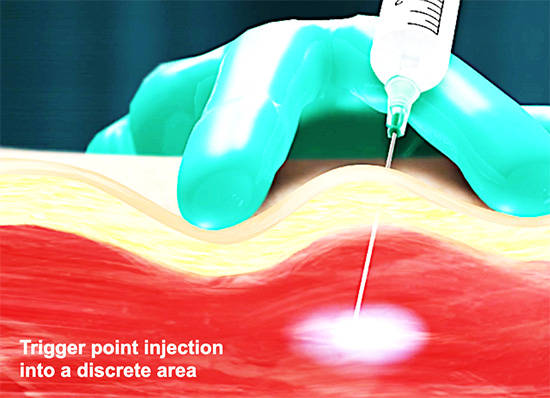
Peripheral nerve injections
A peripheral nerve injection is an injection around a peripheral nerve in the body, both to help with diagnosis and also to produce pain relief. The injection contains local anaesthetic often with a small amount of steroid. The injection is usually undertaken in conjunction with other treatments such as physiotherapy.
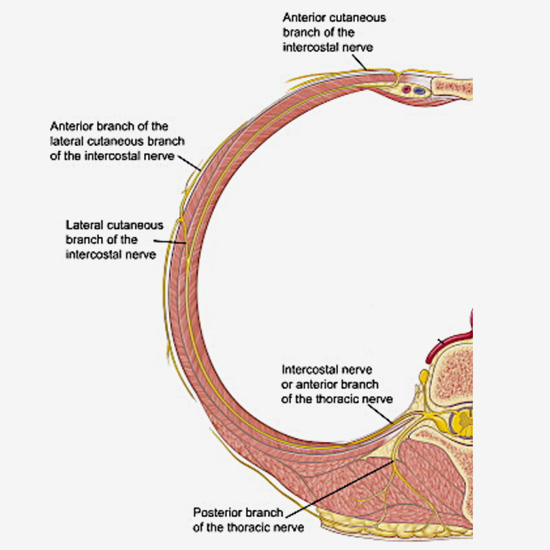
Course of intercostal nerve and its branches through chest wall
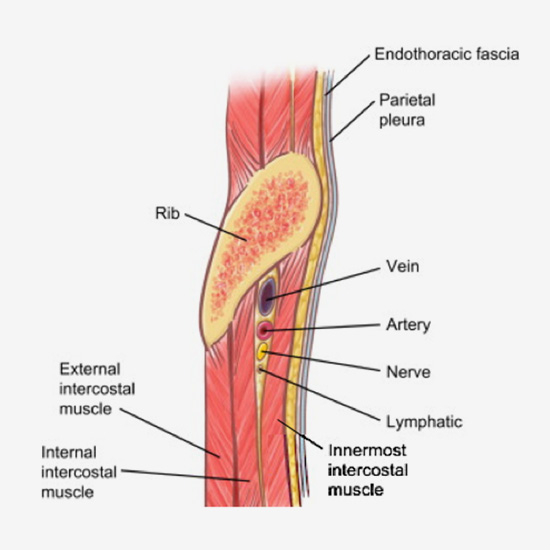
Cross section of chest wall
All peripheral nerve injections are performed with the aim of short to medium-term pain relief and occasionally longer-term benefit as a course of injections, though long-term pain relief usually depends on treatment of the underlying condition through the use of anti-inflammatory pain relief, rest and rehabilitation, physiotherapy or even surgery.
Local anaesthetic in isolation is used for either injection for diagnostic purposes (for example in Slipped Rib Syndrome) or for acute pain relief in postoperative or post-traumatic situations such as rib injuries. Steroids have anti-inflammatory and pain-modulating effects but might take some time for its action to start, during which analgesia is provided by the local anaesthetic.
Peripheral nerve-related pain interventions should be done under ultrasound guidance to allow accurate placement of needles and distribution of injectate; conferring high-procedure success and reduced complication rates including a small risk of pneumothorax (collapse lung) or bleeding (bruising in the soft tissues or even in the chest cavity (haemothorax).
Intercostal nerve block
Intercostal nerve blocks or ‘rib block’ are commonly performed as part of chest surgery and have been routinely used for decades in patients with chest wall injuries. It involves injecting typically local anaesthetic with or without steroid under ultrasound guidance into the area around the intercostal nerve. It results in numbness and pain relief in the thoracic dermatome (area of skin supplied by sensory neurons that arise from a spine). The intercostal nerve block can be multi-level affecting several dermatomes. The pain relief tends to last for a few days only but may be repeated. Specific indications include rib fractures [see rib injury], costosternal or costochondral problems [see complex rib problems] and Slipped Rib Syndrome.
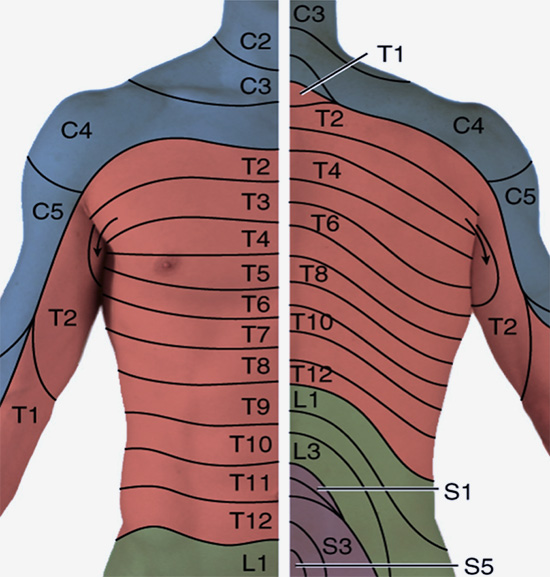
Thoracic dermatomes
Paravertebral nerve block
Paravertebral block is a technique where local anaesthetic is injected into the space adjacent to the vertebrae to block the spinal nerves as they emerge from the intervertebral foramen. It can be formed as an injection into the area or involve leaving a catheter or tube to allows continuous local anaesthetic to be given. It allows a more widespread block of the chest wall. It is often routinely performed at St George’s hospital during thoracic surgery including open reduction and rib fixation for fractured ribs [treatment surgery] but occasionally can be offered with ultrasound guidance in patients with acute chest wall pain usually following trauma.
Serratus anterior nerve block
The ultrasound-guided serratus anterior plane block is a method to anesthetize the chest wall in patients with multiple rib fractures by injecting (and ideally inserting a catheter for continuous local anaesthetic) above or below the serratus anterior muscle. It is used routinely at St George’s hospital in patients presenting acutely with chest wall pain and rib fractures.
Joint injections
Joint injections are used to deliver steroids directly into a joint, such as a knee, ankle, or wrist. Sometimes fluid is removed from the joint before the steroid is injected. Aspirated joint fluid can help your physician diagnose the cause of the swelling joint.
Joint injections involve typically injecting steroids directly into the joint and are used to treat pain in the hip, knee, and shoulder related to Osteoarthritis; Degenerative arthritis; Injury; Stress from poor mechanics and Tendonitis.
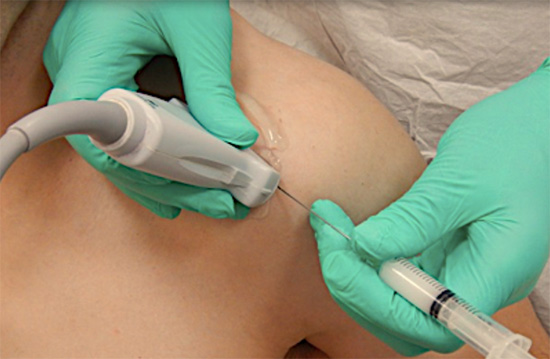
Injection into the shoulder under ultrasound guidance
The types of joint injections available to patients
| Injectable Drug | Use |
|---|---|
| lidocaine or bupivacaine | Most common. Local anaesthetic used alone or often with a another drug. Provides short term pain relief for both the procedure (injection) and underlying inflammatory condition |
| Corticosteroid injections | Most common. Corticosteroid (steroid) injections use a combination of steroid medication and an anaesthetic to reduce inflammation in order to alleviate pain |
| Hyaluronic acid injections | Typically used in the knee. These injections are applied when corticosteroid injections are not successful in relieving pain. Hyaluronic acid is similar to the naturally occurring substance in the body that lubricates the joints. By injecting additional hyaluronic acid into the knee, doctors aim to create more lubrication in the joint, helping it to function properly |
| Platelet-rich plasma injections | Also called PRP injections, use the patient’s own blood to stimulate and encourage the body’s natural healing process of the cartilage and tissues within the joints |
| Placental tissue matrix injections | Also called PTM injections, use placental tissue collected after a healthy birth. Mothers can choose to donate their placenta after giving birth to a child. Placental tissue helps decrease inflammation and promote healing because it contains amniotic stem cells |
The role of joint injections for chest wall problems is more limited, usually involves injecting local anaesthetic usually with steroid and requires expertise due to the technical challenges of injecting accurately and avoiding complications such as bleeding and pneumothorax (collapsed lung).
Chest wall Joints targeted for injections
| Joint targeted | Role |
|---|---|
| Acromioclavicular joint | AC joint injections for pain, osteoarthritis, distal clavicle osteolysis (shoulder joint pain at the end of the collarbone that is the result of bone disintegration and damage) and as a diagnostic test. It’s performed commonly |
| Sternoclavicular joint | SC joint injection for pain, osteoarthritis and as a diagnostic test, performed occasionally |
| Sternocostal | Sternocostal joint injection for pain and inflammation. Tietze’s syndrome is a specific indication but rarely indicated |
| Manubriosternal joint | Manubriosternal joint injection for pain and inflammation but rarely indicated |
| Costochrondral joint | Costochrondral joint injections for pain and inflammation. Tietze’s syndrome or severe costochondritis are specific indications but rarely indicated |
| Xiphersternal joint | Xiphersternal joint injections for pain (xiphodynia) and inflammation but rarely indicated |
| Costotransverse and costovertebral joint | Costotransverse and costovertebral joint injections for pain and inflammation but not commonly performed |
| Thoracic facet joint | Thoracic facet joint injections for pain and inflammation. It’s performed commonly |
Alternative techniques
Other radiological interventions (treatments using x-ray guidance) are occasionally offered though rarely used in managing chest wall problems. Chemical neurolysis, application of chemical agents such as alcohol to a nerve in order to cause a temporary degeneration of targeted nerve fibres. It is frequently performed in celiac plexus, trigeminal ganglion, and lumbar sympathetic chain, but not widely performed on peripheral nerves.
Radiofrequency ablation, electrocoagulation (heat), and cryoablation (cold) of peripheral nerves have been reported to cause successful pain relief, however, it should be performed after demonstrating a good response after peripheral nerve block. These procedures can be performed radiologically under ultrasound guidance or surgically typically keyhole (often called a surgical nerve block).
